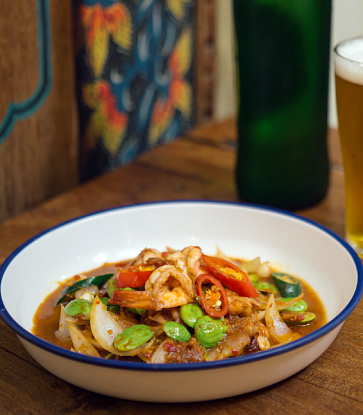Thailand has a hot, tropical climate. So, it is no surprise that Thai cuisine includes many cool dishes. While “khao chae”, a bowl of rice steeped in iced jasmine-scented water, is a famous local favourite for beating the heat, there are other dishes that also offer refreshing bites during the scorching Thai summer.
When it is hot out, some may turn to the crisp cool of shaved ice, ice tea, or fresh salads. In Thailand, thoughts turn to khao chae, taeng mo pla haeng (watermelon with dried fish), yam som oh (pomelo salad), and ma muang nam pla wan (mango with sweet fish sauce).
About five or six years ago, the Thai culinary scene saw a “Return of Khao Chae” trend, which sparked Thai foodies to search for this chilled rice dish. The trend inspired a good many Thai chefs to focus on khao chae, especially khao chae chao wang (for royalty). Originally, it was a Mon dish prepared for special festivals. It became popular in palace kitchens, among the royal family and the nobility. In recent years, before this latest trend, only a handful of people, mainly Baby Boomers, ate khao chae. Now, the delicacy has ventured beyond palaces and found its way onto Thai fine dining menus, regaining popularity as a summer favourite among lovers of Thai cuisine.

Previously, foodies could find khao chae, such as Phetchaburi-styled khao chae chao baan (for commoners), at markets like Nang Leurng Market or among the vendors at the pier Tha Prachan in Bangkok. The side dishes would be shredded meats, shrimp paste balls, and stir-fried sweet radishes for the price of half a bowl of noodles. Nothing fancy, and hard to find. No batter-fried peppers stuffed with minced pork. No carved green mangoes or finger roots. It would be very different from the royal khao chae.
Khao chae is a complicated dish with many steps in its preparation, and the right equipment and ingredients are needed. For example, the rice must be scrubbed to remove any starchy residue; otherwise, the water will become cloudy and unappealing. The Vallaris flowers that bloom in the summer are difficult to find, so jasmine flowers are substituted to float in the fragrant water. Because of that, khao chae was not a regularly prepared dish. Ask for it too often, and the cook might raise an eyebrow. But now, it’s easy because the royal khao chae is widely available, from upscale restaurants to five-star hotels.
This dish is a Thai summertime favourite because the rice is served in iced jasmine water that cools off the heat. It is a fragrant, refreshing dish, but Thailand has other dishes that may be more suited for hot summer days and nights.

Khao chae is a refreshing dish to enjoy when it’s hot outside. But, it can be difficult to find someone to prepare a complete offering. Also, the traditional delicacy isn’t something you might want to get often as it can be expensive compared to other dishes. Most importantly, the cold rice is refreshing and light containing just around 350 kilocalories, so it’s not as heavy as phad thai or phad ka phrao (stir-fried holy basil). But the side dishes are usually fried, which can be uncomfortable and hard to digest.
Summer foods should be light and easy on the stomach as well as refreshing. They should be comforting and not too filling. They should cool and energise. That's what Thai summer foods are all about.
Drawing on old-fashioned, romantic times in Thailand, taeng mo pla haeng is a refreshing, low-calorie dish. Each bite offers comfort and is a perfect balm for the intense heat of Thailand’s summer.
Khanom jeen sao naam (Thai rice noodle with coconut milk) refreshes as a noodle dish is served at room temperature. You can eat it easily, no sweating from the heat. And the chopped ginger and pineapple help settle the stomach. But the sauce is made from coconut milk, which can be heavy and hard to digest. You also need to be sure the coconut milk is fresh and safe to eat in the hot weather, unless you want to cook it yourself to make sure it hasn’t spoiled.
What other Thai summer dishes are there?

According to Prayoon Chanyavongse, a renowned political cartoonist with an unmatched knowledge of Thai cuisine, gaeng som, or Thai sour curry, is an excellent choice for summer. It is spicy and sour, which stimulates appetite, and it is a Thai curry that doesn't consist of coconut milk, so it is lighter on the stomach.
Another dish Khun Prayoon has been recommending for 50 years is stir-fried okra, or phad buab. It is actually a mix of three vegetables: Chinese okra, sponge gourd, and calabash. They should be soaked in water until clean, then peeled and chopped. After heating oil in a pan, fry garlic, add pork (or you can use egg instead), and when the pork is cooked, add the chopped vegetables. Add water and season with fish sauce. Cover the pan and cook until the vegetables are tender. This is a sweetly savoury dish that is easy to eat. Even kids will like it. You can eat it with steamed rice and gaeng som or chilli paste. This summer delight can be prepared economically every day at home, no need for palace specialties.
Furthermore, these three vegetables are believed to have cooling properties. Eating them comforts and soothes. Other cooling vegetables include ivy gourd, bitter melon, melientha leaves, and morning glory, so you have a wide variety to choose from.
Summer in Thailand can last many months. You may crave for royal khao chae or mango sticky rice. But for any ordinary hot day, stir-fried okra, sour curry, chilli paste, and clear soup with ivy gourd and minced pork make excellent, tasty choices.



















